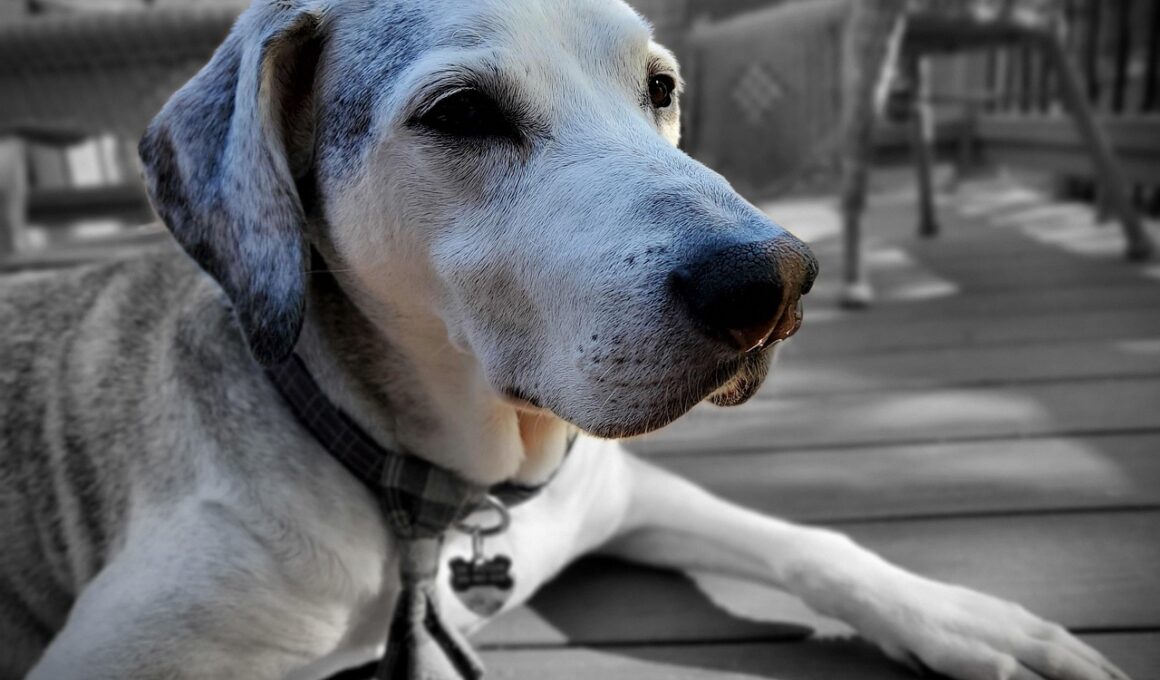Managing Respiratory Emergencies in Senior Dogs
As our dogs age, they often face a myriad of potential health challenges, including respiratory issues that can arise unexpectedly. Recognizing the signs of distress in senior dogs is vital for timely intervention. Symptoms like excessive panting, difficulty breathing, or coughing can indicate serious conditions that worsen quickly. Promptly responding to these signs can keep your dog from experiencing severe consequences. Age-related conditions like congestive heart failure or pneumonia can lead to respiratory emergencies, detailing the importance of being vigilant. Owners should be familiar with their dog’s normal breathing rates to monitor any changes effectively. Consider keeping a record of typical respiratory behavior as this can help when consulting with your veterinarian. Understanding your dog’s needs and changes helps foster a proactive approach to their health. Visiting a vet regularly is crucial since many respiratory issues can be asymptomatic until they become acute. Keep a first aid kit on hand and familiarize yourself with emergency protocols, as these can be lifesaving in moments of crisis. Prevention and awareness can significantly improve your senior dog’s quality of life, especially during these emergencies.
Once your senior dog exhibits signs of respiratory distress, immediate action is paramount. Begin by assessing your dog’s vital signs, including heart rate and respiratory rate. With senior dogs, the typical respiratory rate can vary; however, a consistent rate above 30 breaths per minute is generally concerning, necessitating help. Ensure your dog remains calm, as panic can worsen breathing problems. Try to control their environment, reducing stressors as much as possible. Creating a familiar space with their favorite blanket and toys can provide comfort during these trying times. You may wish to place your dog in a position that eases their breathing, often lying upright or with their front legs elevated. Monitoring their response to positioning can provide valuable information for veterinarians. If your dog collapses or becomes unresponsive, immediately implement basic first aid. Performing CPR can be crucial; ensure to reach out for assistance while taking swift action. Always have a plan ready: keep contact details of veterinary clinics and emergency pet services readily available. Knowing where to go can help save precious time when every second counts in a respiratory emergency.
Common Causes of Respiratory Issues
There are several common causes behind respiratory emergencies in senior dogs that every owner should be aware of. Allergies can play a prominent role in respiratory distress, prompting reactions that lead to wheezing and coughing. Additionally, chronic diseases such as kennel cough, bronchitis, and pneumonia frequently affect older pets. Cardiac diseases are also prevalent; congestive heart failure often leads to fluid accumulation in the lungs, severely affecting breathing. Furthermore, tumors or growths in the chest can obstruct airways or cause discomfort, emphasizing the necessity for regular veterinary check-ups. Infections, especially upper respiratory infections, can cause inflammation that leads to distress. Keep an eye out for unusual discharge from the nose, which could signal an issue needing attention. An important aspect of managing these conditions is to ensure a safe and healthy environment for your senior dog. Redirecting them away from smoke, dust, or strong odors can be an effective preventive measure. Also, maintaining a clean living space helps limit exposure to irritants that could trigger respiratory distress.
In addressing respiratory emergencies, there are several steps you can take to assist your senior dog effectively. First, ensure a safe and calm space with minimal distractions to help ease their anxiety. Next, monitor their breathing closely; attempts to engage them in gentle physical activity should be avoided if breathing seems labored. Position your dog in a way that prioritizes their comfort, typically sitting or standing to facilitate easier airflow. If your dog’s condition does not improve, it is essential to remain calm and seek immediate assistance from your veterinarian or emergency pet clinic. Before you arrive, collect information about their symptoms, duration, and any changes in behavior to facilitate accurate assessment by veterinary professionals. Providing thorough background information may expedite your dog’s treatment. If you suspect that agitation or distress could situate your dog into a state of panic, consider having someone accompany you to help with calming techniques during transport. Staying informed about your senior dog’s medical history and needs plays a crucial role in their long-term care and health management.
First Aid Techniques for Breathing Difficulties
When performing first aid on dogs facing breathing difficulties, several techniques can be beneficial. The first step is to calmly approach your dog; it’s vital to maintain a soothing demeanor, as they may pick up on your anxiety. Next, evaluate their airway; in cases of choking, try to dislodge the object by gently performing back thrusts, while being careful to avoid further injury. If your senior dog shows no signs of responsiveness, utilize the modified CPR method suitable for dogs. Place your hand just behind the elbow, compressing the chest gently but firmly. Combine this with mouth-to-snout resuscitation by sealing your lips around your dog’s mouth, delivering a breath every 4–6 seconds. Maintain the rhythm until you reach emergency care or until your dog revives. Knowing these techniques can potentially save lives. It’s also valuable to familiarize yourself with the symptoms indicating that first aid may be necessary in the first place. A proactive approach will help ensure you’re well-prepared for any emergencies that may arise.
Because respiratory issues can escalate quickly, preventing them in senior dogs is essential. Regular veterinary check-ups are crucial, as these can help monitor heart and lung health through routine examinations and blood tests. Vaccination against infectious diseases, like canine influenza or kennel cough, is another preventive measure that should not be overlooked. Further, maintaining a healthy lifestyle through balanced nutrition and regular exercise can significantly enhance a senior dog’s overall well-being. Consulting your vet about proper diet options can lead to improved health and vitality, particularly for older dogs. Nutrition rich in omega fatty acids promotes better skin and respiratory health, while hydration is equally important. Cold fresh water should always be available to your pet. Moreover, consider incorporating supplements that support respiratory function, under veterinary guidance, into their diet. While not all respiratory issues can be prevented, increasing overall health improves resilience against potential ailments. Engaging in these proactive measures is essential, ensuring prolonged companionship with your beloved senior dog and enhancing their quality of life.
Conclusion and Support Resources
In conclusion, promptly managing respiratory emergencies in senior dogs is vital for preserving their health and ensuring their comfort. Familiarizing yourself with symptoms, performing first aid when necessary, and knowing when to seek veterinary help are essential tools for any dog owner. Additionally, keeping updated with preventive measures can significantly reduce the likelihood of respiratory issues occurring. Emphasizing education on common respiratory problems, providing a stress-free environment, and maintaining regular health check-ups with a veterinary professional can lead to improved outcomes for your senior dog. Demonstrating love and attention through knowledge goes a long way in fostering a meaningful journey with your cherished pet. For further support regarding respiratory health in dogs, turn to reliable resources like the American Animal Hospital Association or your local veterinary clinics. Such organizations specialize in providing up-to-date information and guidance tailored to senior dog care. Forming a network of trusted veterinary experts ensures a solid support system, reinforcing the importance of preventive and emergency care. Together, leveraging these resources will significantly benefit you and your senior dog’s health.
If you find yourself unsure about any signs of distress or require advice on managing health-related challenges, reach out to professionals. The earlier you notice symptoms, the better your chances of addressing them promptly, ultimately preserving quality time with your furry friend.


